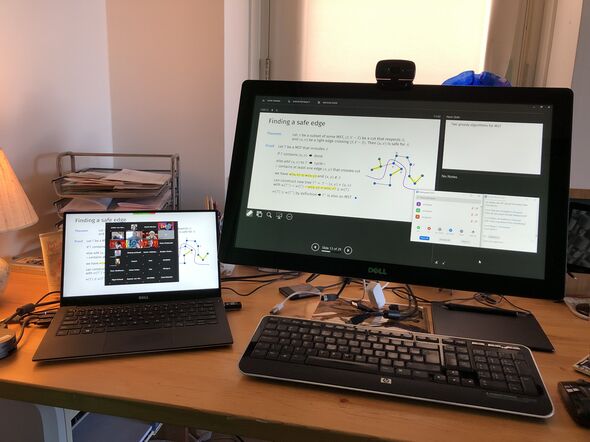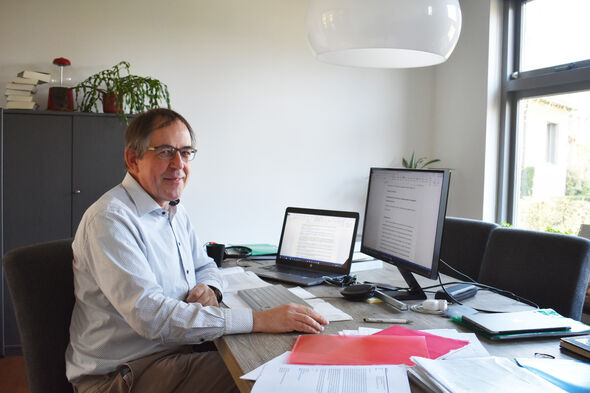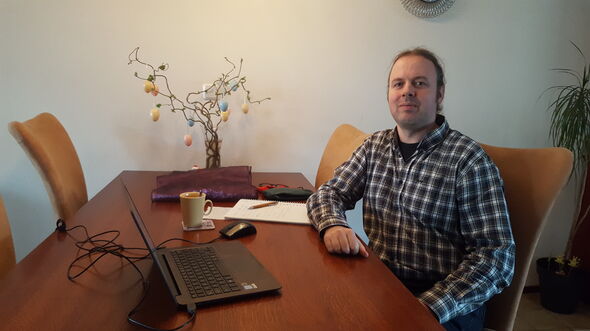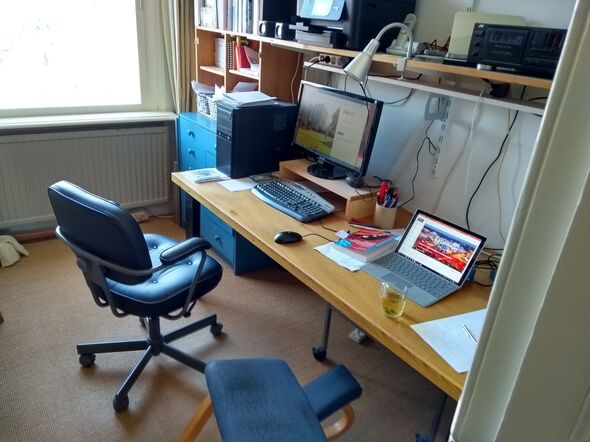Online education, how do our lecturers do that?
The past few weeks have been very educational for teachers who were not yet fully skilled at creating online education. Many had to work under great pressure but received plenty of support from employees of Education & Student Affairs (ESA) and Information Management & Services (IMS). Both within their own department and at a central level. This way TU/e managed to get almost all education online in time. This process must now also be carried out for Q4. Four teachers share their experiences.
Neither one of her group had any experience with live-streaming a lecture from their living room, says professor Bettina Speckmann, head of the group Applied Geometric Algorithms at the department of Mathematics and Computer Science. “My co-teacher Arthur van Goethem and I really wanted to keep things interactive, so we decided to try a live-stream with Zoom. Last week on Monday we had 297 participants and on Wednesday still 250. Everything worked really well. We did notice quickly that it is very important to have a co-host who answers chat questions, lets you know when to repeat something, who alerts you to questions from the audience, and who also kicks out the one student who started posting twitch links.”
Speckmann talked a lot with the ESA members in her own department. All were very helpful and worked tirelessly, she says. "However, I am really disappointed by decisions that were taken on a central level by IMS. Zoom is the only tool which allows interactive lecturing for 100+ students. Nevertheless, they decided not to support it, for vague GDPR reasons. Luckily my department is running a Zoom pilot and that is how I got a license in the end. It is not expensive and it works really well. Why not support lecturers in these stressful times with tools that work and they actually want to use? And let me not get started on the Office 365 push. My laptop crashed epically, I spent all Sunday resurrecting it, and all that when I needed it to teach on Monday. Why, oh why?"
So many faces
According to what Speckmann heard the students were quite positive about the Zoom lectures and the interactions (chat, non-verbal reactions such as 'yes/no' or 'thumbs up/down'). "In fact it seems that many more students feel comfortable to ask questions in the chat than in a normal class room. It was also nice to see many faces (Zoom supports up to fifty simultaneous camera feeds) and talk to an actual person. Well, a live video stream. The interactivity was really valued and students said that it was clearly better than a video lecture."
By the end of Q3 Speckmann herself is done teaching, but will still be guiding Master’s students. "That will have to continue online with weekly meetings. My cluster, Algorithms, is teaching three courses in Q4. For two of them things will mostly work as usual, we are going to use Zoom again to provide interactive lectures. The third course is more difficult to move online and will have to change substantially."
She is not very worried about the coming exam period. “For some years now we are using OnCourse for our homework assignments, so it was comparatively easy for us to create an online exam and run a trial with Proctorio and OnCourse. So I am confident that it will work out fine during the coming exam period.”
University professor René Janssen heads up the interfaculty research group Molecular Materials and Nanosystems. He counts himself lucky not to have any experience with online lectures. “When I was a student one or two courses were making use of video lectures. That was still in the days of videotape and a black-and-white TV. I managed to watch ten minutes. Then I upped and left, and started reading the book written by the same professor. If online education is the future, I'll be looking for a real job,” says Janssen.
Over the past few weeks, however, everything has gone fairly smoothly for Janssen. “During Q3 I was working on three different courses and I taped the last couple of lectures, either standing in front of a surreally empty lecture theater or sitting at home and using a PowerPoint video, which meant staring at a screen. It all worked, but I wouldn't say it was enjoyable. Guided self-study is something I've offered via Skype. We haven't seen much of that this past week. I'm going to revisit whether that is the right method.”
"Lesson for the future"
Janssen says he has been helped greatly by Yvonne Vervuurt and Daian Saman Yan, ESA staff members at Applied Physics and Chemical Engineering and Chemistry, respectively. “It's great how everyone is pitching in to get this job done. The Canvas sites that have been created for lecturers are full of tips and tricks. It's also good that lecturers themselves are largely in control and aren't now having to jump through all kinds of hoops and red tape when they want to modify something. That's a lesson for the future.”
In Q4 Janssen, together with professor Paul van der Schoot, will be teaching the course ‘Thermal Physics’ for students of Applied Physics. “We'll be delivering that online. Video lectures from last year are available and all the other information is also already in digital form. In principle, we've got this course sorted, but how to really reach the students is something we are still pondering. Some 250 students are involved and even under normal circumstances that's a challenge for two lecturers. Added to which, it's a course that many students find difficult.”
Exam period
What troubles Janssen most is the final projects for the bachelor's and master's. “I'm a firm believer in theory, in simulations and in modeling, but nothing beats a successful experiment. So I hope we'll soon be able to get back into the lab with the students and can get back to stirring in pots, measuring a spike in activity, or making something or other. As Max Planck once said, ‘Experiments are the only means of knowledge at our disposal. The rest is poetry, imagination’. That the speaker is such a distinguished theoretical physicist only adds to the weight of these words.”
Janssen's only real concern is the exam period. “In the coming period I am the responsible lecturer for exams on three bachelor's courses and co-lecturer on another two courses. So I'm preoccupied with the exams. I am learning as much as I can about online testing, because I am - or rather I should now say 'I was' - old school. You do an exam on paper. If it were up to me, none of the five exams would be postponed or cancelled. We'll manage, one way or another.”
For Rudie Kunnen, assistant professor at the Department of Applied Physics, digital education was completely unknown territory until two weeks ago. “My course, Signals & Systems, is Design-Based Learning, and it involves students working on an experiment in groups. So that's now out of the question. Fortunately, part of the assignment involves modeling the system. The model can be simulated, so students will still be able to get some results. So we've gone the simulation route, wholeheartedly. And of course, in the report we'd be delighted to see any experimental results previously gained.”
The fact that in the week before all education came to a compulsory halt, individual presentations were planned to take place, was for Kunnen the trickiest aspect of the digital transformation. “What could I do?” asks Kunnen. “To live stream or record an actual presentation every student has to have a large screen or a projector. That's pretty difficult to arrange. We eventually opted for screencasting: making a film of slides with a voice-over by the student. We haven't yet received the films, I am curious to see how they have turned out.”
Initial hesitation
To maintain the interaction with students, Kunnen and his fellow lecturers decided to make themselves available to answer questions via Skype during the normal working hours of the course. “Even so we are noticing some initial hesitation among students,” says Kunnen. “Whenever we walk among the groups in our usual rooms in Flux, questions arise unprompted. Things are a little quieter on line at the moment. But after a week students seem to be adapting, more questions are starting to trickle in.”
For Q4 Kunnen will record lectures and think carefully about the best form for the interactive sessions that will replace the regular tutorials that are now off the timetable. The coming exam period won't pose him any problems because his students will be required to produce a report and submit it digitally. For the Q4 exams, he expects that by the time they roll around, plenty of best practice will be available from the exam period in Q3.\
Nico Dellaert is an Associate Professor and Chair of Quantitative Analysis of Stochastic Models for Logistic Design in the department of Industrial Engineering & Innovation Sciences. One of the modules he is teaching this quarter is Healthcare Management.
"It's part of the bachelor elective course Healthcare Management and Modeling. In the modeling part students have to develop epidemiologic models for virus infections - so extremely insightful these days, whereas in the management part we discuss the planning and control of all kind of hospital activities."
Unfortunately, Dellaert says, planning for conditions such as the Netherlands and the rest of the world have to face today is not part of the teaching material. "Students can take the Healthcare Management module in two different modes, the assignment mode and the participation mode. The assignment mode was originally developed for students that could not be present in the classes because of their final Bachelor Project, but it has become quite popular nowadays, as many students tend to avoid classrooms and prefer to work at their own pace, at the time and place that suits them best."
Guest lecture cancelled
The participation mode is of course the one that Dellaert and his co-teachers like the most. "Students have to prepare the material before the classes, give presentations, ask questions and discuss the material. Due to the Covid-19 crisis, the last three classroom sessions could not be done in the normal settings. The discussion on one paper was there for cancelled, as well as the guest lecture from a hospital planner, whose presence was more valuable at the Zuyderland hospital. But there were still four topics to be discussed and presented by our participation students."
Following the suggestion from the ESA advisors at his department, Dellaert examined the use of Canvas Conference for having the last online sessions. "A nice instruction movie made everything look very simply, but in the first four solo sessions I became quite desperate, as the system was terribly slow and I did not discover some essential control buttons. Only when I changed my internet connection from Wi-Fi to a fixed cable, I saw the resemblance with the instruction movie and I set up a joint meeting with the four presenting students."
Problems
In the practice session with four students all students were able to take the presenter role, but some of them still had serious hardware problems, with a slow shared Wi-Fi connection, a non-working microphone or camera. "Obviously, cellphones are more important for students than their laptops," Dellaert says.
Last Monday the first two ‘real‘ sessions took place for which all the students were invited. But just before the first session Dellaert and his students discovered another serious problem. "When you give a power-point presentation Canvas converts the .ppt file into a pdf, loosing all information about the power-point animations. For this problem we found a workaround, in which the presenter shares her screen with the power-point. Unfortunately, in the screen-sharing option she cannot see the questions and answers in the chat from the other students. So, in the first session, I took the moderator role by reading the chat box aloud."
In these sessions Dellaert did not use the camera yet, as it might distract the students from the sheet presentation, "but in future sessions we might try various options from Canvas Conference. I think that in this case the careful preparation paid out and we had great presentations from two of the students, and I already look forward to the next sessions."








Discussion